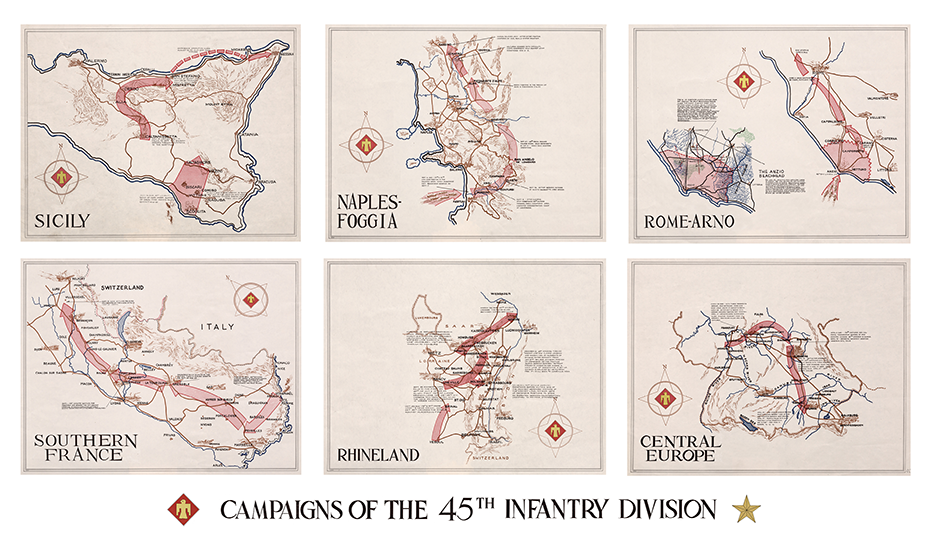45th INFANTRY DIVISION - Thunderbird
Activated 16 Sep 1940 • Entered Combat 10 Jul 1943 Sicily • Days of Combat 511 • Casualties 20,933
Commanding Generals
Maj. Gen. William S. Key (Sep 40 - Oct 42)
Maj. Gen. Troy H. Middleton (Dec 42 - Dec 43)
Maj. Gen. William W. Eagles (Dec 43 - Dec 44)
Maj. Gen. Robert T. Frederic (Dec 44 - Sep 45)
Campaigns
Sicily (9 Jul - 17 Aug 43)
Naples-Foggia (9 Sep 43 - 21 Jan 44)
Anzio (22 Jan 44 - 24 May 44)
Rome-Arno (22 Jan 44 - 9 Sep 44)
Southern France (15 Aug 44 - 14 Sep 44)
Rhineland (15 Sep 44 - 21 Mar 45)
Central Europe (22 Mar 45 - 11 May 45)
This vintage map chart the journey of the 45th Infantry Division throughout World War II. The map can be zoomed in and purchased at HistoryShots.com.
DIVISION CHRONICLE
The 45th Division landed in North Africa, 22 June 1943, and trained at Arzew, French Morocco. It landed in Sicily, 10 July, in its first major amphibious operation and moved inland under minor opposition. The enemy resisted fiercely at Motta Hill, 26 July, before losing the fourday battle of "Bloody Ridge." On 1 August, the Division withdrew for rest and patrols. On 10 September 1943, the second landing at Salerno occurred. Against stiff resistance, the 45th pushed to the Calore River, 27 September, crossed the Volturno River, 3 November, and took Venafro. Until 9 January 1944, the Division inched forward into the mountains reaching St. Elia north of Cassino before moving to a rest area. The 45th landed at Anzio, 22 January 1944, and for 4 months stood its ground against violent assaults. It went over to the attack, 23 May, crossed the Tiber River, 4 June, outflanking Rome and withdrew for rest and training on the 16th. The 45th participated in its fourth assault landing, 15 August 1944, at St. Maxime in Southern France. Against slight opposition, it spearheaded the drive for the Belfort Gap. It took the strongly defended city of Epinal, 24 September, crossed the Moselle River and entered the western foothills of the Vosges, taking Rambervillers on the 30th, and crossing the Mortagne River, 23 October. After a brief rest the 45th cracked the forts north of Mutzig, an anchor of the Maginot Line, 25 November, crossed the Zintzel River and pushed through the Maginot defenses. From 2 January 1945, the Division fought defensively along the German border, withdrawing to the Moder River. On 17 February, it went back for rest and training. The 45th moved north to the Sarreguemines area and smashed at the Siegfried Line, 17 March, taking Homburg on the 21st and crossing the Rhine between Worms and Hamm on the 26th. The advance continued, Aschaffenburg falling, 3 April, and Nurnberg on the 20th. The Division crossed the Danube, 27 April, took Munich on the 30th and as war ended was stationed near Dachau.
Date Activated is the date the division was activated or inducted into federal service (national guard units).
Casualties are number of killed, wounded in action, captured, and missing.
The dates after the campaign name are the dates of the campaign not of the division.
The Army Almanac: A Book of Facts Concerning the Army of the United States; , U.S. Government Printing Office. Army Battle Casualties and Nonbattle Deaths in World War II, Final Report, 1 December 1941 - 31 December 1946. US Army Center of Military History at http://www.history.army.mil/ Various divisional histories


